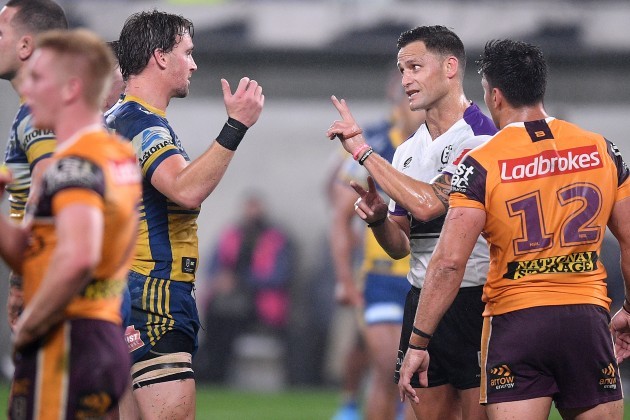RED-CARD REPLACEMENTS, CAPTAIN’S Challenges and goal-line drop-outs will be trialled during the Guinness Pro14 Rainbow Cup after approval from World Rugby.
The three new laws will be tested when the competition kicks off on Friday week with local derbies in Ireland, Scotland, Wales, Italy and South Africa.
The laws are already in use in both New Zealand’s Super Rugby Aotearoa and Australia’s Super Rugby AU, and World Rugby CEO Alan Gilpin welcomed their introduction on a trial basis in one of the northern hemispheres premier competitions.
“We applaud Pro14 Rugby and the respective clubs for their enthusiasm to trial a number of law variations in the Rainbow Cup,” Gilpin said.
“The addition of another top competition to the World Rugby law trials programme will provide invaluable data and feedback to determine future advances to game spectacle and player welfare.”
Red-card Replacement
The red-card replacement innovation will see an offending player sent off for the duration of the match as is normal but, after 20 minutes, they can be replaced by a substitute.
Similarly to how the 10-minute sin bin is applied for a yellow card, the 20-minute player deficit for a red card will be measured in ‘game time’, i.e. the clock pause during stoppages in play. The law will also apply when a player is sent off after receiving two yellow cards..
Players who have already been withdrawn from the field for tactical reasons may still be used to replace a player who has received a red card after the 20-minute period. The usual replacement laws also apply whereby a replaced player may return for an injured front rower (for injuries caused by foul play, head injuries or blood injuries).
Captain’s Challenge
The captain’s challenge “is aimed at enhancing the accuracy of decisions already under the remit of the match officials,” say the Pro14.
Each team is allowed one challenge but if it is made successfully, they keep their challenge. These can be used for try-scoring and foul-play incidents, or to challenge any refereeing decision in the last five minutes of a match.
A captain’s challenge will be referred to the TMO who will review the footage after which the match referee making the final decision. Challenges can only be made up to 20 seconds after the referee has blown his whistle for a stoppage in play and only incidents from the last passage of play can be challenged.
In the first 75 minutes of a game, the captain’s challenge can be used solely to check for an infringement in the lead up to a try or to review foul play. It will be applied more broadly in the last five minutes plus injury time at which stage the captain can seek a review of any whistled decision — regardless of whether nor not a try has been scored.
Rules for challenges:
- TMOs will be able to review any incident which has occurred since the last stoppage in play, regardless of how many phases have been played in the interim.
- Foul-play challenges can be made after any stoppage in play if the captain believes foul play has been missed by the match officials.
- Captains must reference ‘specific’ incidents or infringements.
- Footage must be ‘clear and obvious’ for a challenge to be upheld.
- Captains cannot refer a scrum or lineout penalty, where the referee’s decision will be final.
What can’t be challenged:
- Quick restarts in play, e.g. quick taps or quick lineouts.
- Non-decisions, i.e. where a referee does not blow their whistle for a decision and play continues (except for in the cases of alleged foul play).
- Set-piece decisions: these are technical decisions that could provide multiple outcomes based on the interpretations of players and referees.
Goal-line drop-out
When a ball is held up over the line, knocked on in the in-goal area or grounded in goal by a defending player after a kick-through, the defending team will take a drop-out from anywhere on or behind their goal line.
The kick must travel five metres past the goal line and, if it doesn’t, the opposing team can request a retake or a five-metre scrum in line with where the kick was taken.
A missed penalty kick at goal or a missed drop-goal attempt will still result in a 22-metre drop-out for the defending team.
“Our Sports & Regulatory Committee have been very proactive in identifying opportunities to introduce game innovations and we’re looking forward to implementing these trials during the Guinness Pro14 Rainbow Cup,” said David Jordan, the Pro14′s tournament director.
“We know these laws also have their origins from the Player Welfare Symposiums and our belief is that we will see a positive impact on the game overall.”


